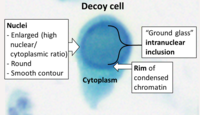
Photo from wikipedia
Allogeneic HCT recipients may develop BK virus (BKV)-associated hemorrhagic cystitis (BKV-HC), typically early after engraftment. Yet, BKV levels in urine and blood are not routinely monitored pre- or post-HCT. Among… Click to show full abstract
Allogeneic HCT recipients may develop BK virus (BKV)-associated hemorrhagic cystitis (BKV-HC), typically early after engraftment. Yet, BKV levels in urine and blood are not routinely monitored pre- or post-HCT. Among HCT recipients with primary immunodeficiency diseases (n=40), we prospectively monitored BKV levels by quantitative PCR in blood and urine pre-HCT, as well as weekly post-HCT through day +100 on NCT02579967. Thirty patients were considered at-risk for BKV-HC based on BKV detection in urine/blood at any timepoint. Of these, 22 (73%) developed BKV-HC. Of recipients treated on the reduced-intensity conditioning (RIC) busulfan-containing arms of the trial, 22 of 27 (81%) at-risk patients developed BKV-HC (Fig 1). By contrast, on the non-myeloablative conditioning arms, identical to RIC except for the absence of busulfan (Fig 2), 0 of 3 at-risk patients developed BKV-HC (p=0.01). No patients received antiviral or cellular therapies for BKV-HC, although 3 received cidofovir and/or brincidofovir for adenovirus infection. Three required continuous bladder irrigation; 1 required multiple cystoscopies for clot evacuation but no intravesicular therapy. Disease outside the bladder was rare: 1 patient (Fig 1 - P36, with notably atypical pattern of BKV levels in relation to symptoms) developed tissue-proven BKV nephropathy, along with radiographic and cytopathologic (SV40+ cells on bronchoalveolar lavage) evidence of BKV pneumonitis; thus, further evaluation for extravesicular disease, particularly in those without significant gross hematuria, is under way. Patient discomfort and supportive care needs were significant, especially during gross hematuria (n=19; median duration 21 days, range 2-41; see Fig 1). With neutrophil engraftment at median day +17 (range 13-42), median onset of BKV-HC symptoms was day +22 (range +5-74), with median duration of 26 days (range 6-145 days). Starting on day +21, the trajectory of urine BKV levels diverged between RIC-HCT recipients with or without BKV-HC (Fig 3), with significantly higher BKV in urine at day +28 for BKV-HC patients, median 8.98 log10 IU/mL, compared to those without, median 4.99 log10 IU/mL, Mann-Whitney p=0.02. At BKV-HC onset, median level of BKV in urine was 9.66 log10 IU/mL (range 6.01 to >9.81) and, at full resolution, 8.39 log10 IU/mL (range 2.87 to >9.81). Swimmer's plot (Fig 1) shows the peak in urine BKV to occur soon before or early into symptom onset in most and that blood BKV peak levels vary more in timing. In conclusion, in this cohort, the use of busulfan seems to be an important co-factor in BKV-HC risk, as also noted by others. The trajectory of BKV levels in urine differed between those with and without BKV-HC, although the identification of early BKV-HC predictors is limited by the short interval between divergence in case/control values and symptom onset.
Journal Title: Biology of Blood and Marrow Transplantation
Year Published: 2020
Link to full text (if available)
Share on Social Media: Sign Up to like & get
recommendations!